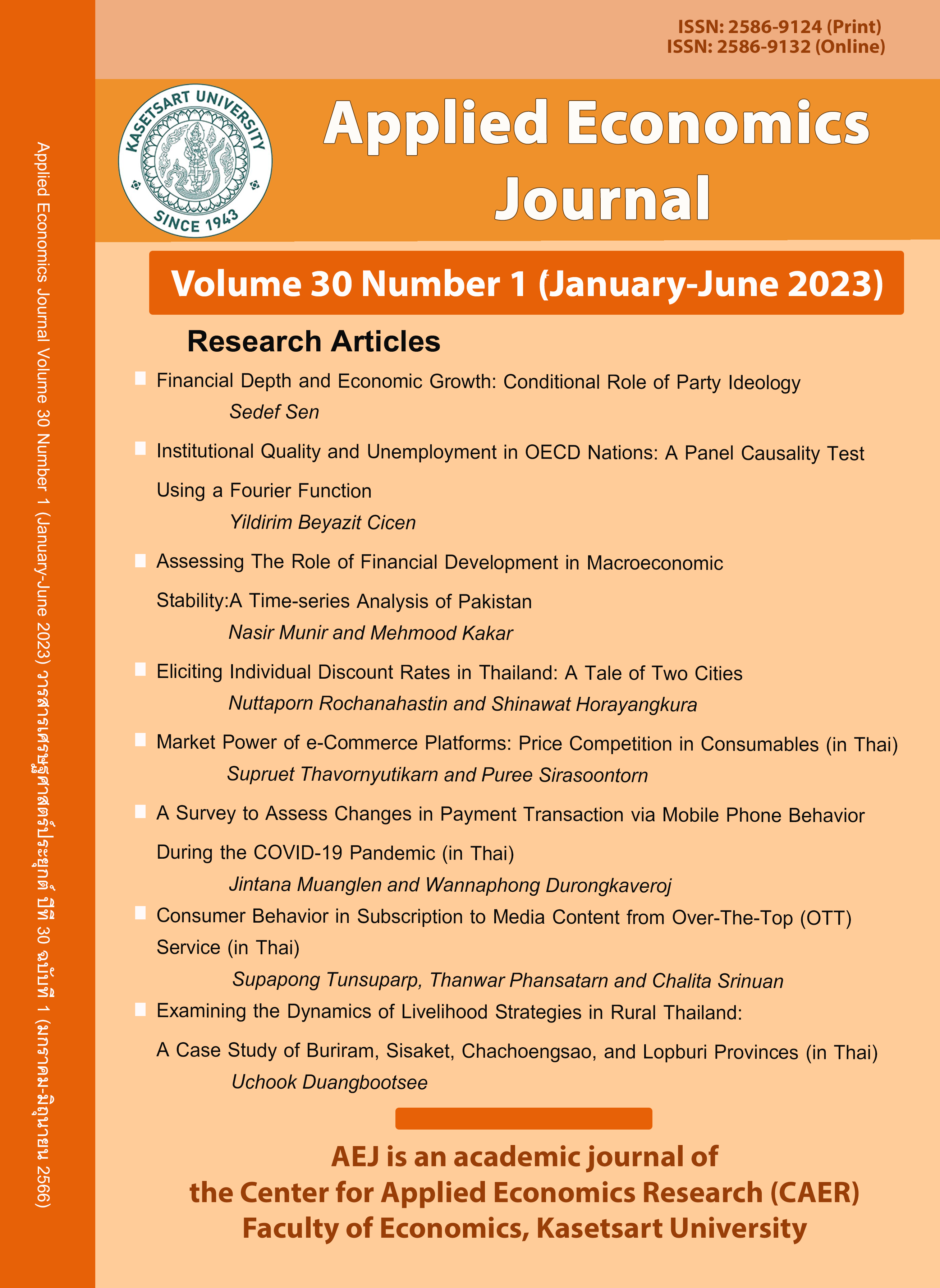Consumer Behavior in Subscription to Media Content from Over-The-Top (OTT) Service
Main Article Content
Abstract
Over-the-top (OTT) services for content programming are growing rapidly in Thailand. Services are generally provided in both paid and free ad-supported formats. This research examines the behavior of paying for additional OTT services for content programming. The analysis is divided into two steps: the decision-making process between paid and free formats and an analysis of factors affecting the paid service format. Heckman’s two-step estimation is used to solve the problem of systematically selected data, combined with data from a survey of OTT service users in Thailand, which was conducted by the National Broadcasting and Telecommunications Commission in 2019. The results show that several factors lead to a higher likelihood of choosing the free format. Additionally, some factors increase the likelihood of users paying less for the service. The study highlights the importance of non-tariff factors in the decision-making process of users, which can be used as a competitive tool by free ad-supported OTT service providers against paid service providers. Regulatory agencies can use the study's findings to monitor the competition in the OTT service market for content programming in Thailand.
Article Details

This work is licensed under a Creative Commons Attribution-NonCommercial-NoDerivatives 4.0 International License.
The paper is published under CC BY-NC-ND, in which the article is freely downloaded and shared in its original form non-commercially and its citation details are identified.
References
Baumol, W. (1986). Microtheory: Applications and origins. Cambridge, MA: The MIT Press.
Bondad-Brown, B. A., Rice, R. E., & Pearce, K. E. (2012). Influences on TV viewing and online user-shared video use: Demographics, generations, contextual age, media use, motivations, and audience activity. Journal of Broadcasting & Electronic Media, 56(4), 471-493.
Chaveesuk, S., & Vongjaturapat, S. (2012). Theory of information technology acceptance. KMITL Information Technology Journal, 1(1). (in Thai)
Elsafty, A., & Boghdady, A. (2022). The cognitive determinants influencing consumer purchase-intention towards subscription video on demand (SVoD): Case of Egypt. International Journal of Marketing Studies, 14(1), 95-113.
Filistrucchi, L., Geradin, D., van Damme, E., & Affeldt, P. (2014). Market definition in two-sided markets: Theory and practice. Journal of Competition Law & Economics, 10(2), 293-339.
Greene, W. H. (2017). Econometric analysis. Pearson Education.
Gujarati, D., & Porter, C. (2008). Basic econometrics. New York, NY: McGraw-Hill Education.
Heckman, J. J. (1979). Sample selection bias as a specification error. Econometrica, 47(1), 153-161.
Kim, M. S., Kim, E., Hwang, S., Kim, J., & Kim, S. (2017). Willingness to pay for over-the-top services in China and Korea. Telecommunications Policy, 41(3), 197-207.
Kim, S. J. (2014). A repertoire approach to cross-platform media use behavior. New Media & Society, 18(3), 353-372.
Kwak, K. T., Oh, C. J., & Lee, S. W. (2021). Who uses paid over-the-top services and why? Cross-national comparisons of consumer demographics and values. Telecommunications Policy, 45(7), 102168.
Lee, C. C., Nagpal, P., Ruane, S. G., & Lim, H. S. (2018). Factors affecting online streaming subscriptions. Communications of the IIMA, 16(1), Article 2.
Lee, S.-E., Choi, M., & Kim, S. (2019). They pay for a reason! The determinants of fan’s instant sponsorship for content creators. Telematics and Informatics, 45(4), 1-12.
Medina, M., Herrero-Subías, M., & Portilla, I. (2019). The evolution of the pay TV market and the profile of the subscribers. Revista Latina de Comunicación Socia, 74, 1761-1780.
Office of the National Broadcasting and Telecommunications Commission (NBTC). (2019). Predicting the number of viewers for OTT media service: A comparison of the global market and the OTT market in Thailand (2019-2023). Retrieved from: https://broadcast.nbtc.go.th/data/academic/file/620800000002.pdf (in Thai)
Office of the National Broadcasting and Telecommunications Commission (NBTC). (2021). OTT Thailand. Retrieved from: https://broadcast.nbtc.go.th/ott_thailand (in Thai)
Phansatarn, T., Srinuan, C., & Srinuan, P. (2022). Demand for Thai mobile telecommunications and market power measurement. Applied Economics Journal, 29(1), 56–77. (in Thai)
Perloff, J. M. (2020). Microeconomics: Theory and applications with calculus. New York: Pearson.
Quah, S. H., & Tan, A. K. G. (2009). A Heckman sample selection approach to the demand for organic food products: An exploratory study using Penang data. Journal of Food Products Marketing, 15(4), 406-419.
Srinuan, C. (2015). Over-the-Top (OTT): Beginning of war in the new ICT ecosystem. Information Technology Journal, 11(1), 74-81. (in Thai)
Taneja, H., Webster, J., Malthouse, E., & Ksaizek. (2012). Media consumption across platforms: Identifying user-defined repertoires. New Media and Society, 14(6), 951-968.
The Netherlands Authority for Consumers and Markets. (2017). A closer look at online video platforms. Retrieved from: https://www.acm.nl/sites/default/files/documents/2017-10/acm-a-closer-look-at-online-video-platforms-2017-10-16.pdf
Tunsuparp, S. (2021). Over-the-Top (OTT) user behavior under users’ negative attitude. Applied Economics Journal, 28(1), 101–120. (in Thai)
Venkatesh, V., Morris, M. G., Davis, G. B., & Davis, F. D. (2003). User acceptance of information technology: Toward a unified view. MIS Quarterly, 27(3), 425-478.


